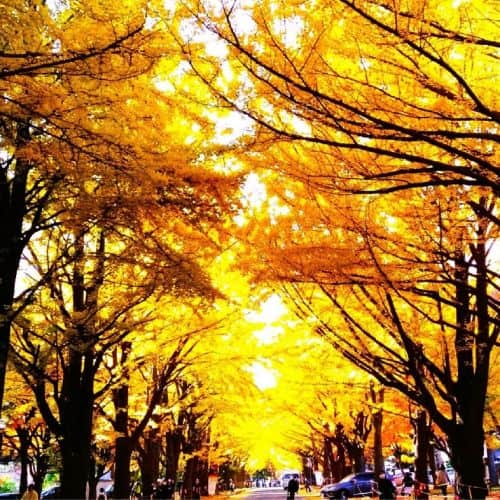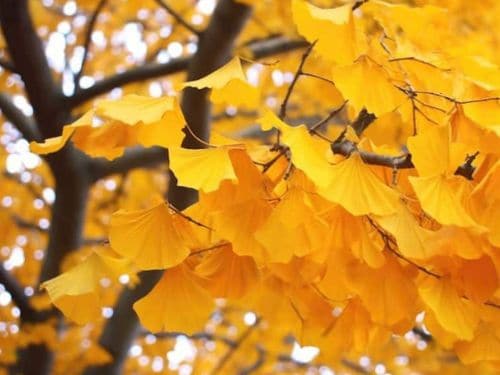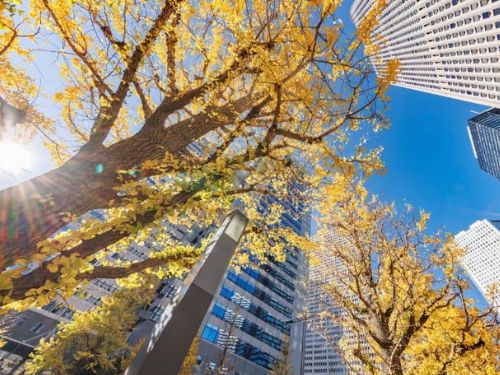The Ginkgo tree is often called a living fossil; records indicate that ginkgo trees have been thriving on Earth for over 200 million years, making them one of the oldest tree species on the planet. Fossils resembling modern-day ginkgo leaves date back to the Permian period, and the tree’s presence persisted through the age of dinosaurs. This tree found its stronghold in Asia, and became intertwined with Chinese culture and philosophy. Today, the ginkgo is distributed worldwide, gracing urban landscapes and gardens with its distinctive fan-shaped leaves.

Growing and Caring For Ginkgos
Ginkgo trees are hardy and adaptable but thrive in well-drained soil and full sunlight. When selecting a location for planting, choose a spot with good drainage. Ginkgo trees can tolerate a range of soil types, but they prefer slightly acidic to slightly alkaline soil. Planting a ginkgo tree is relatively straightforward once you’ve found the ideal location. Young ginkgos are often available as container-grown saplings or balled and burlapped specimens, and they should be planted in the spring or fall.
While ginkgo trees are known for their resilience, proper watering is crucial during the establishment phase. Newly planted ginkgos should be watered regularly to keep the soil consistently moist. Once established, ginkgos are drought-tolerant and can withstand periods of dryness. However, supplemental watering is beneficial during prolonged dry spells, especially in hot climates. Applying a balanced, slow-release fertilizer in the spring can support healthy growth. Avoid excessive fertilization, as ginkgos are not heavy feeders and can thrive in nutrient-poor soils.
Pruning typically minimal, as Gingkos are naturally symmetrical. However, occasional pruning may be necessary to remove dead or damaged branches and to shape the tree for aesthetic purposes. It’s best to prune during the dormant season in late winter or early spring to minimize stress on the tree. Ginkgos are resilient to pruning and can tolerate a range of pruning intensities. When pruning, use clean, sharp tools to make precise cuts and avoid removing more than a third of the tree’s canopy at a time.
Ginkgos are generally resistant to most pests, but aphids and scale insects can occasionally pose problems. Insecticidal soaps are effective and environmentally friendly solutions. Diseases such as leaf spot and root rot can occur in poorly drained soils. Ensuring proper drainage and maintaining good overall tree health are essential preventive measures. Regular inspections of the tree for any signs of pests or diseases allow for early intervention, ensuring the continued health and vitality of the ginkgo.
Size and Growth Rate
Ginkgo trees typically reach heights of 50 to 80 feet and attain a spread of 30 to 40 feet as they mature. The tree’s central leader grows upward, forming a strong and well-defined trunk, while its lateral branches gracefully spread out horizontally. Their slow to moderate growth rate makes them suitable for various landscapes, from urban environments to large estates. The growth habit of ginkgo trees is well-balanced, and they typically maintain a pyramidal shape throughout their lifespan.
Leaves and Flowers
The ginkgo’s most iconic feature is undoubtedly its fan-shaped leaves. These leaves are unlike any other in the plant kingdom, resembling delicate fans or the wings of butterflies. They are usually divided into two lobes, creating a unique and instantly recognizable appearance. As autumn approaches, the ginkgo undergoes a stunning transformation. The green foliage turns into a brilliant display of gold and silver hues, creating a visual spectacle that attracts admirers from far and wide. This vibrant seasonal change has contributed to the ginkgo’s use in parks, gardens, and city streets.
Ginkgos are dioecious, meaning there are male and female trees, and only the female trees produce the fruit, known as ginkgo nuts. The seeds are encased in fleshy, plum-like structures, which emit a pungent odor when they fall to the ground. Despite their strong aroma, ginkgo nuts are considered a delicacy in some cultures and are used in culinary dishes and traditional medicine.

Medicinal Properties of Ginkgo Biloba
For centuries, various parts of the ginkgo tree, particularly its leaves, have been utilized for their therapeutic properties. Ginkgo biloba extract is renowned for its potential cognitive benefits. Rich in flavonoids and terpenoids, the extract is believed to have antioxidant properties that may help protect cells from damage caused by free radicals.
Additionally, Ginkgo is thought to enhance blood flow to the brain, potentially improving memory and cognitive function. These purported benefits have led to the widespread use of ginkgo supplements, particularly in the context of age-related cognitive decline.
Beyond its cognitive benefits, ginkgo has been employed in traditional medicine to address a range of ailments. It has anti-inflammatory and anti-platelet effects, potentially useful for asthma, arthritis, and cardiovascular disorders. While ginkgo has a long history of use in traditional medicine, scientific research on its efficacy is ongoing.
Cultural Symbolism
The ginkgo tree is deeply rooted in cultural symbolism and artistic traditions. In East Asia, particularly in China and Japan, the ginkgo symbolizes longevity, resilience, and hope. It is often depicted in traditional paintings, poetry, and literature as a sacred and auspicious tree. One of the most celebrated instances of ginkgo symbolism is found in Japan, where the tree is associated with the Hiroshima ginkgo. This particular ginkgo tree, located near the Hiroshima Peace Memorial, miraculously survived the atomic bombing of Hiroshima in 1945. Despite being just one kilometer from the blast epicenter, the tree continued to thrive and became a powerful symbol of hope and resilience in the face of adversity.
In Western cultures, the ginkgo captured the imagination of influential figures such as Vincent van Gogh, who immortalized the ginkgo tree in his paintings. The tree’s unique leaves and elegant form have inspired poets, writers, and artists across generations, adding to its cultural significance as a symbol of endurance and beauty.
Cities and towns embrace the ginkgo tree for its hardiness, adaptability, and aesthetic appeal. Ginkgo-lined streets transform into golden canopies during the autumn season, creating a breathtaking display that draws residents and tourists alike. The tree’s tolerance to urban conditions, including pollution and compacted soil, has contributed to its popularity as a street tree. Ginkgo trees can be found gracing the sidewalks of major metropolises, providing shade and beauty amid concrete jungles.

Preserving an Ancient Legacy
While the ginkgo tree has demonstrated remarkable resilience over millions of years, it faces contemporary challenges threatening its survival. Urban development, pollution, and climate change all pose potential threats to ginkgo populations. Additionally, the cultivation of ginkgo trees for ornamental and medicinal purposes has led to genetic uniformity, making the species more susceptible to diseases and pests.
Conservation efforts are underway to protect and preserve the genetic diversity of ginkgo populations. Botanical gardens, arboreta, and research institutions play a crucial role in studying and safeguarding ginkgo trees. Through seed banking and propagation programs, efforts are made to conserve the unique genetic material of different ginkgo varieties, ensuring the tree’s continued existence for generations to come.
